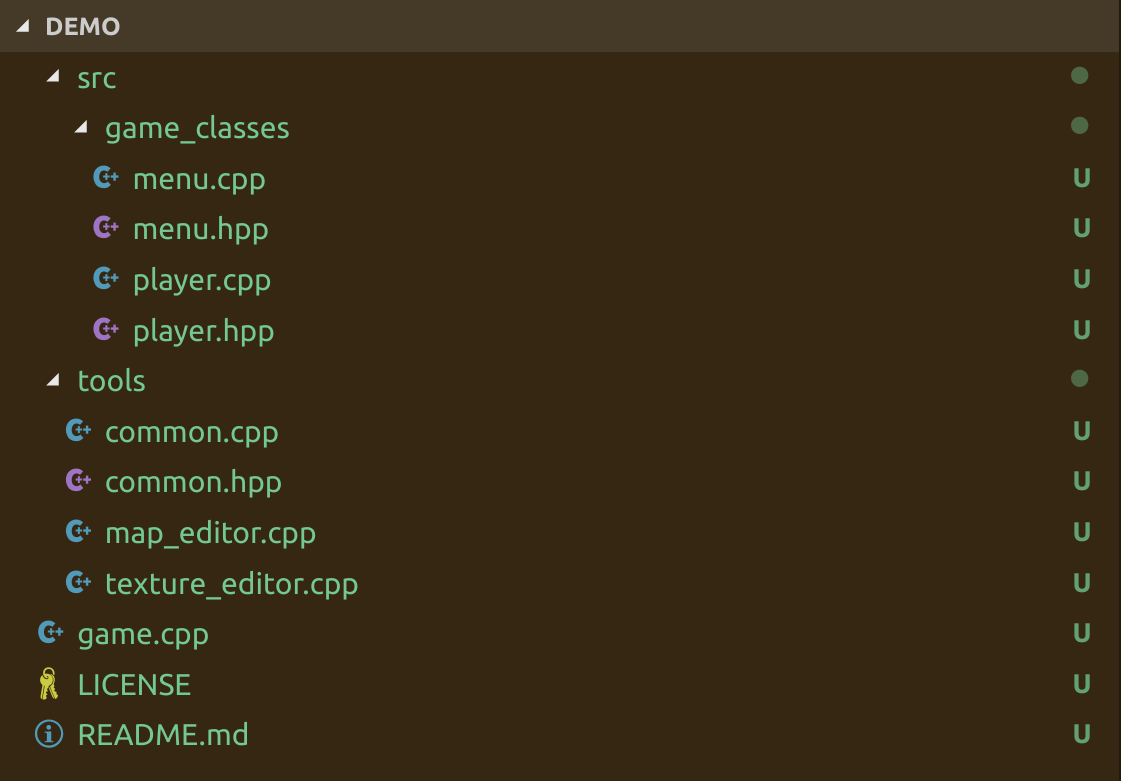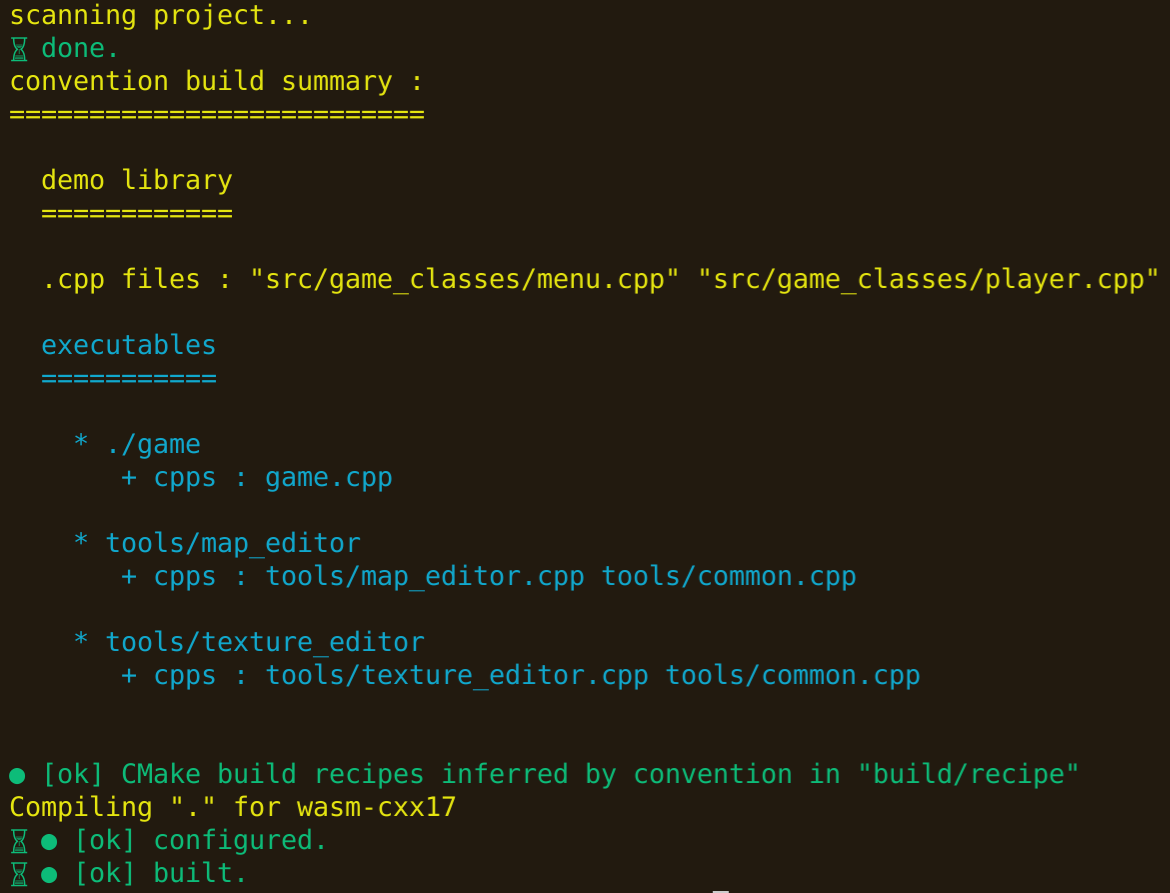Builds by Conventions¶
Why ?¶
Why did we ever write makefiles ? CMakeLists.txt or configured IDE project settings ? And why can we stop ?
Andrew Koenig once coined FTSE, the Fundamental theorem of software engineering :
“We can solve any problem by introducing an extra level of indirection.”
Actually building application is an extremely complex problems, and the layers are almost infinite : linker, assembler, compiler, frontend, build-system ( e.g. make), meta-build-system ( e.g. cmake) to quote only a few.
nxxm leverages all the fabulous work done in these layer to finally make building C++ a simple human task.
Because¶
- C++ code expresses enough what is an application entrypoint and what is reusable library code.
- No need to learn a new language to specify how to build.
- We are tired of specifying each single file that should be built.
Convention by example¶
Take the idea of building a game project. This game project will contain :
- the game domain with the player characters, game menu and so on.
- the game app itself
- tools apps like game maps and texture editor.
The directory could look like this :

game.cpp has a main function each, therefore they are apps by convention.
The main function may look like :

The src/ folder is scanned by nxxm which notices that there are .hpp and .cpp that don’t have any entrypoint, therefore it defaults to the library code ( i.e. the game domain ).
Finally tools/ isn’t quite a good name for library code, and there are map_editor.cpp and texture_editor.cpp that both have main() functions.
Which makes them app entrypoint. Therefore the apps convention kicks in.
This apps convention allows to have supporting file aside, therefore common.cpp is linked to map_editor and texture_editor. The header common.hpp is accessible via #include "common.hpp" while the game_classes is exported on the compiler include dirs which makes them usable via #include <game_classes/*.hpp>.
nxxm will give the following summary:

Resulting in a bin folder like the following:
bin
├── game.exe // game.cpp
├── demo.lib // game_classes *.cpp
└── tools
├── map_editor.exe // common.cpp, map_editor.cpp
└── texture_editor.exe // common.cpp, texture_editor.cpp
Conventions Types¶
First main convention : every project is a library. ( c.f. Every project is a library ).
Out of each git repositories passed to the nxxm program one library is produced.
Hint
All the conventions can be mixed and don’t need to be declared beforehand, they are getting detected.
Hint
While often unneeded due to the conventions mentioned below it is possible to specify or reduce the scope of a library within a project with nxxm -s library-dir or { "s" : "library-dir" }.
splitted libs¶
.
├── include
│ └── header.hpp
└── src
└── impl.cpp
One typical kind of c++ project is when headers and implementation files are splitted in different folders, if it happens to be so nxxm will consider the include/ folder to be the publicly installable headers and src the implementation files constituing the library.
Hint
By default nxxm checks the presence of include/ inc/ src/ sources/ to infer this convention.
samedir libs¶
.
└── src
├── header.hpp
└── impl.cpp
Another typical convention C++ programmer uses are the implementation and headers together at the same level of directory hierarchy.
Hint
By default nxxm checks the presence of src/ sources/ to infer this convention and the absence of main() functions in the files.
toplevel libs¶
These are libraries that don’t have any special source folder, their headers are directly rooted at the top of their repositories.
When this is detected the same mechanism as for samedir libs applies.
Hint
With this kind of structure it might be required to disambiguate nxxm to tell him which directories are really part of the lib thanks to nxxm -s library-dir or { "s" : "library-dir" }.
headeronly libs¶
It is possible to have code which is completely header only while application entrypoints are in .cpp files aside materializing either lib examples or a corresponding app.
The headers will be put at disposal like in the aforementioned conventions with #include <>.
apps¶
any .cpp file with an entrypoint is an app.
For example any file containing a main() function or a macro instantiating a main() function ( e.g. unit testing frameworks ) will be compiled as an application.
Hint
apps are always linked to the project library.
Hint
if others .cpp files are aside in the same or deeper filesystem directory they get linked with the applications in question. Except when those directories are part of the explicitely declared “s”/-s project library dir.
test or examples¶
Same as apps convention, however the project will register them within the CMake CTest test driver and calling nxxm . --test all will run them all and report result status
This convention kicks-in when files with main() functions in parent folder are named after :
- test
- tests
- example
- examples
html¶
Any .html containing <script type="text/c++"></script> in it is compiled as an app convention.
Conventions are not enough¶
It could happen, please contact us so that we can improve nxxm or help you.
You can also tweak the build as explained below, this is however not recommended and goes against our vision. But we don’t bite. :)
There is for sure a way for the convention build to work : less is more. Or put differently less CMakeLists is more time for your C++. (^^)
Override for one directory convention build¶
This can be useful for really custom test framework or cases, you can give the hand to your CMake skills by adding in the subdiretories you don’t want nxxm to do conventional builds.
Simply add an empty marker file use-cmake.nxxm and a valid CMakeLists.txt. The build will use CMake for this subpart.
Tweak nxxm convention build¶
We rely on CMake on you can tweak how we interract with it.
We don’t recommend it but you can tweak fully or partially the build by adding CMakeLists.txt.tpl files in the main or sub directories of your project.
To generate a sample CMakeLists.txt.tpl with the docs embedded of the different variables at your disposal call nxxm cmaketpl.